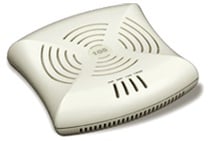Wireless Access Points are one of the most important parts to choosing a WLAN Solution. The access point, and specifically the frequency type they use, can make or break the experience the end user will have.
You hear terms like: "dual band", "dual radio", "single band", "single radio", "MIMO", "mesh", "bridging" and on and on.

But what does it all mean?
And what access point should you consider for your network?
Here is a quick breakdown of access point frequencies - just one very important part of the entire wireless network design.
3 options for wireless access point frequencies include:
- 2.4 GHz
- 5 GHz, or both.
The 2.4 GHz band has been around since we started using 802.11 for wireless network access.
The pros: the 2.4 band are that almost everything will work on this band, meaning the laptop from 2001 with an external USB wireless adapter or the iPad you bought last week.
The cons: 2.4GHz is a very popular band and thus is very crowded. Bluetooth devices, cordless phones and other things that occupy the same spectrum can interfere with the signal.
5 GHz Wireless Access Point
The pros: The 5 GHz band however is not as crowded as the 2.4 GHz band.
The cons: The down side is that not all devices are 5GHz capable, so putting an entire network only on that band is not recommended - yet.
Dual Band Wireless Access Point
Dual radio access points can do both 2.4 & 5ghz. Dual radio access points is a great way to ensure that your network has the ability to grow over time.
The pros: Dual radio access points have the ability to service clients on one radio and use the other for things like dedicated video (I.P cameras, Streaming video) mesh, VoIP or any other service you will be running over your WLAN that can benefit from a performance increase. Dual access points can also handle more clients because of the ability to have them on two separate radios. Some WLAN solutions will “load balance” clients between the two radios putting 5Ghz capable clients on that radio thereby freeing up space on the 2.4Ghz radio for clients limited to only that band.
The cons: The only downside to dual band is of course that is costs more than the single radio/single frequency wireless access points.
A good WLAN design will take into account the requirements for bandwidth, connectivity, application usage, client capacity and propose the appropriate access point solution. Please contact us if you would like to discuss a design, or simply have additional questions. SecurEdge Networks even has a free guide to help you with your wireless network design.




